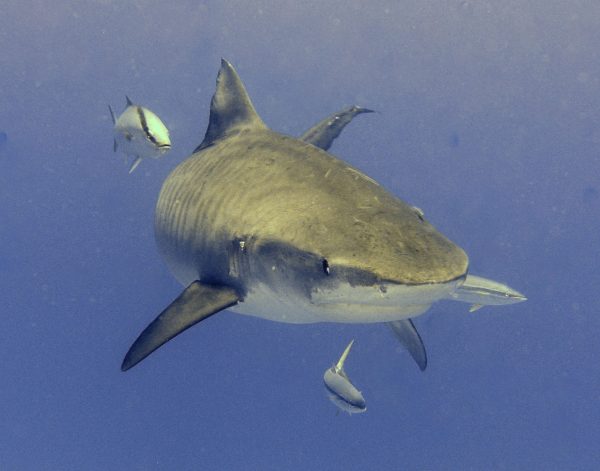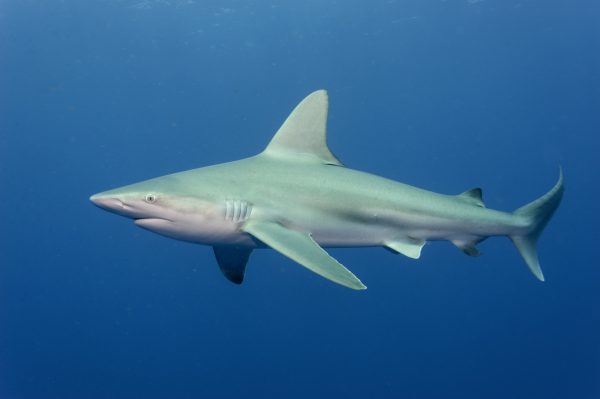The world experienced the lowest number of shark attacks since 2009, although fatalities in 2013 were above average, according to the Florida Museum’s International Shark Attack File report released today.

Photo by Derek Smith
The U.S. saw a decrease in attacks with 47, lower than the 2012 total of 54, which was the highest yearly total of the current century. There were 10 fatalities worldwide, which is higher than the 10-year average from 2003-2012. Two localities, Western Australia (six deaths in past four years) and Reunion Island (five deaths in three years) in the southwest Indian Ocean, remained shark-attack hot spots, while places where shark activity is typically rare or nonexistent also experienced attacks, said George Burgess, curator of the file housed at the Florida Museum of Natural History on the UF campus.
“When sudden increases in shark attacks occur, usually human factors are involved that promote interactions between sharks and people,” Burgess said. “Shark populations are not in a growth phase by any means, so a rise in the number of sharks is not to blame. However, we can predict with some reliability that shark attacks will concurrently rise with the growth of human populations, a trend we saw throughout the past century.”
Seventy-two unprovoked attacks occurred worldwide, which was lower than 2012 and represents the lowest global total since 2009 when there were 67 attacks. In recent years, Burgess said, globalization, tourism and population growth worldwide have led to shark attacks in historically low-contact areas like Reunion Island, Papua New Guinea, Madagascar, Solomon Island and the small island Diego Garcia in the Indian Ocean, which in 2013 saw its first recorded shark attack. As more people enter the water in these areas, they become equal opportunity locations for shark-human interaction, he said.
“Globalization of societies and the ease of modern travel means that we have access to places that have never been frequented by tourists before,” Burgess said. “Remote destinations are not typically medically equipped to handle a serious shark attack. This situation is a key factor in the higher death rate this year. When a shark attack happens in a remote place, the results are going to be more dire than if it happened on a Florida beach, for instance.”

Photo by David B. Snyder
Traditionally leading the world in shark attacks, North American waters saw 34 attacks in 2013 compared with 43 in 2012. Yearly fluctuations in attacks are normal because changes in ocean systems and economics, and human conditions affect the opportunities for humans to encounter sharks, Burgess said.
The 47 U.S. incidents include Hawaii, which is not recorded as occurring in North American waters by the International Shark Attack File database. Florida led the country with 23, followed by Hawaii (13), South Carolina (6) and one each in Alabama, California, North Carolina, Oregon and Texas. The single U.S. fatality occurred in Hawaii. Most incidents in Florida occurred in Volusia County (8), a historical hot spot that has experienced more than one-third of Florida’s shark attacks, which is attributable to the heavy draw of surfers and tourists to its attractive beaches, Burgess said.
The 13 attacks recorded in Hawaii were higher than its recent average of 4.3. Burgess said spikes occurring over the past two years on the island of Maui could be due to an increase in area surfers, who globally encountered sharks most often in 2013 in 46 percent of reported cases, while swimmers were affected by 31 percent of attacks, followed by divers, with 14 percent. Although Australia experienced an average year with 10 attacks and two fatalities, international attention has been drawn to the country regarding incidents in Western Australia that resulted in the controversial reinstatement of government-sanctioned culling hunts for endangered white sharks in December.
“Even if one ignores that an endangered species is involved, the archaic reaction can only be characterized as ‘revenge killings,’” Burgess said. “Although infrequent, shark attacks are high-profile events that excite the emotions of human beings and often impact a community. Killing 10 sharks after a death is not the answer as it does not result in reduced attacks. This problem has been faced in other locations around the world and addressed in more effective ways.”
In addition to shark-culling activity in Australia and in Natal, South Africa, Burgess said shark populations are declining significantly as a result of over-fishing and habitat loss, with 30 million to 70 million sharks killed every year by fisheries. People, he said, pose a greater threat to sharks than sharks do to humans.
“Sharks have a lot more to fear from us than we do from them,” Burgess said. “Statistically, shark attacks are extremely rare, especially considering the number of humans that enter the water each year.”
Burgess said that as in any wilderness experience, it is humans’ responsibility to avoid dangerous situations, or risk meeting a shark and potentially paying the consequences. He emphasized the role that scientific research can have in reducing shark attacks by creating a better understanding of the species.
“When scientists study sharks and develop more information about how they move and why they attack, it allows us to recommend measures that reduce the chances of sharks and people meeting,” he said. “One-on-one in the ocean, the shark has the advantage. But, by better understanding where and when it is safe to be in the ocean, we can better avoid those encounters.”
Learn more at the International Shark Attack File site.
Learn more about the Ichthyology Collection at the Florida Museum.